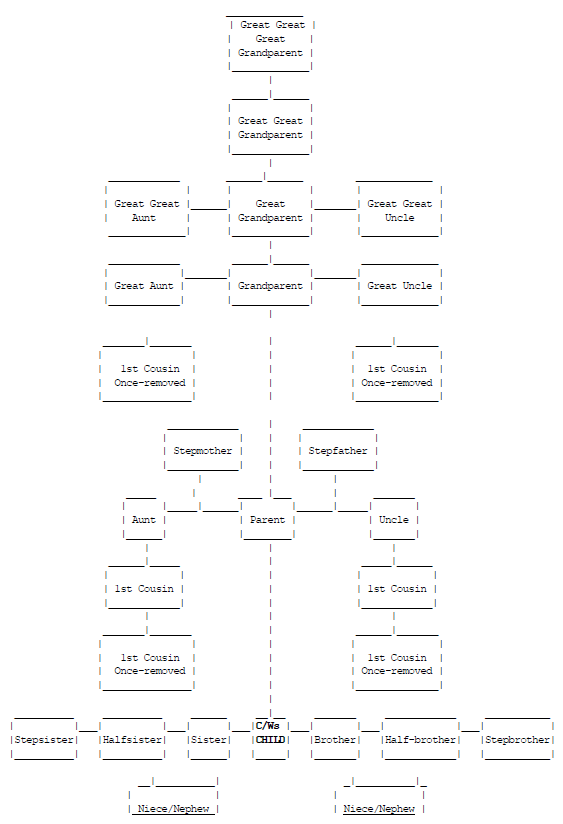|
|
Chart of Relatives Who May Be Caretaker Relatives for Eligible Child
Click herehere to view the chart.

- All persons listed on this chart are shown in their relationship to the CalWORKs child. For example, persons listed as “first cousins” are first cousins to the CalWORKs child.
- The caretaker relative also includes the spouse or former spouse of all the relatives listed above.
- The caretaker relative also includes the adoptive parents and their relatives as listed above.
- The relationship must be clearly documented in the case record.
For a case where the child is a dependent of the court, refer to Miller v. Youakim.
Spouses of Relatives
An acceptable caretaker relative is the spouse of any person named above, even after the marriage has been terminated by death or dissolution.
Adoptive Relatives
An acceptable caretaker relative is a person who legally adopts the child, or that person's relatives, as specified above.
Once a child is adopted, the adoptive parents are legally responsible for that child's support. Therefore, if there is an absent parent deprivation, the "Notice and Agreement for Child, Spousal and Medical Support" (CW 2.1 N&A) and "Support Questionnaire" (CW 2.1Q) must be completed on the absent adoptive parent.
Relinquishment
When a child has been relinquished, adopted, or parental rights are terminated, the caretaker relative is any of the relatives specified above.
This means that for a child who has been adopted, the caretaker relative relationship considers both the biological and adoptive relations.
Documentation
If the caretaker relative is other than a parent, the relationship with the child must be documented. Relationship must be verified when possible. The recipient's signed statement is acceptable in the absence of other verification.
“Statement of Relationship” (CW 790)
The CW 790 may be used to clearly establish the relationship. This should be completed by the EW during the interview and signed by the recipient to ensure it is correct. The CW 790 is not a mandatory form for CalWORKs. It is an aid to help the EW establish and document the correct caretaker relationship.
When the caretaker relative's relationship to each child is the same, only one CW 790 is needed. ExampleExample
If the caretaker relative cares for two children and has a different relationship to each child, it may be necessary to complete two separate CW 790. Example Example
Reminder: There are many ethnic groups that establish relative status by arrangement. The EW must ensure that the relationship between the child and the caretaker/relative is a legal or blood relationship.
Acceptable Evidence
The following evidence may be used to verify the relationship of a child to the caretaker relative:
- Adoption papers or records
- Baptismal records of birth and parentage
- Birth certificate
- Bureau of Vital Statistics or local government records of birth and parentage
- Census records
- Church records, including statements from priests, ministers, etc., of parentage or relationship
- Court records of parentage
- Court support records
- Day care center records
- Divorce papers
- Family Bible
- Hospital or public health records of birth and parentage
- Indian census records
- Insurance policy
- Juvenile court records
- Marriage licenses/records
- Outpatient care records maintained by a hospital, clinic, or physician
- Paternity records maintained by a Child Support Agency
- School records
- Voluntary social service agency records.
No Evidence
If all efforts to obtain other evidence have failed, the applicant/recipient may complete "Part 2: Penalty of Perjury Statement Supporting Degree of Relationship" of CW 790 or sign a "Sworn Statement" (GEN 853) when:
- There is no conflicting evidence, and
- The attempts to obtain the required verification are in the case record, and
- There is documentation that the applicant/recipient and/or the EW are continuing to secure the required verification.
Conflicting Information
When evidence is conflicting, inconsistent, or incomplete, the investigation must be pursued to the point that the preponderance of evidence supports the determination regarding the applicant's eligibility.
As long as there is no conflicting evidence or information, there is no basis to deny aid to a child solely because the relationship to the caretaker has not been established by the Department of Child Support Services (DCSS).
When the caretaker relative is an UNDOCUMENTED NON-CITIZEN WITHOUT ANY IDENTIFICATION, or a non-parent (such as an aunt, uncle, or grandmother), verify that this individual is, in fact, a qualifying relative.
When it is believed that there may be conflicting information or there is no supporting documentation, a paternity referral to DCSS may be made if this situation would require a referral for paternity. The EW must note on the "Referral to Local Child Support Agency (LCSA)" (CW 371) what action is needed.
If there is nothing in the case record to link the caretaker and the child, a GEN 853 must be taken, and a copy forwarded to DCSS with the paternity referral.
When there is conflicting information, obtain sufficient information to support the determination of eligibility.
Related Topics
Caretaker Relative Requirements
Needy & Non-Needy Caretaker Relatives
Approved Relative Caregiver (ARC) Funding Option Program
Pregnant Person in an AU with Another Eligible Child, or Otherwise Eligible SSI/SSP Child